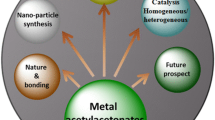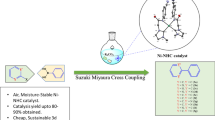Abstract
A mild, environmentally friendly method for reduction of aromatic nitro group to amine is reported, using zinc powder in aqueous solutions of chelating ethers. The donor ether acts as a ligand and also serves as a co-solvent. Water is the proton source. This procedure is also a new method for the activation of zinc for electron transfer reduction of aromatic nitro compounds. The reduction is accomplished in a neutral medium and other reducing groups remained unaffected. The ethers used are dioxolane, 1,4-dioxane, ethoxymethoxyethane, dimethoxymethane, 1,2-dimethoxyethane, and diglyme.
Similar content being viewed by others
References
Abiraj, K., Srinivasa, G., & Gowda, D. C. (2005). Palladiumcatalyzed simple and efficient hydrogenative cleavage of azo compounds using recyclable polymer-supported formate. Canadian Journal of Chemistry, 83, 517–520. DOI:10.1139/v05-071.
Ashley, J. N., Berg, S. S., & MacDonald, R. D. (1960). The search for chemotherapeutic amidines. Part XVI. Amidinoanilino-1,3,5-triazines and related compounds. Journal of the Chemical Society, 1960, 4525–4532. DOI: 10.1039/jr9600004525.
Bellamy, F. D., & Ou, K. (1984). Selective reduction of aromatic nitro compounds with stannous chloride in non acidic and non aqueous medium. Tetrahedron Letters, 25, 839–842. DOI:10.1016/s0040-4039(01)80041-1.
Dupont, J., de Souza, R. F., & Suarez, P. A. Z. (2002). Ionic liquid (molten salt) phase organometallic catalysis. Chemical Reviews, 102, 3667–3692. DOI: 10.1021/cr010338r.
Dyson, P. J., Ellis, D. J., Welton, T., & Parker, D. G. (1999). Arene hydrogenation in a room-temperature ionic liquid using a ruthenium cluster catalyst. Chemical Communications, 1999, 25–26. DOI: 10.1039/a807447j.
Gowda, D., Mahesh, B., & Shankare, G. (2001). Zinc-catalyzed ammonium-formate reductions: Reduction of nitro compounds. Indian Journal of Chemistry Section B, 40, 75–77.
Harmon, R. E., Gupta, S. K., & Brown, D. J. (1973). Hydrogenation of organic compounds using homogeneous catalysts. Chemical Reviews, 73, 21–52. DOI: 10.1021/cr60281a003.
Hazlet, S. E., & Dornfeld, C. A. (1944). The reduction of aromatic nitro compounds with activated iron. Journal of the American Chemical Society, 66, 1781–1782. DOI:10.1021/ja01238a049.
Ho, T. L., & Wang, C. M. (1974). Reduction of aromatic nitro compounds by titanium(III) chloride. Synthesis, 1974, 45. DOI: 10.1055/s-1974-23246.
Johnstone, R. A. W., Willby, A. H., & Entwistle, I. D. (1985). Heterogeneous catalytic transfer hydrogenation and its relation to other methods of reduction of organic compounds. Chemical Reviews, 85, 129–170. DOI: 10.1021/cr00066a003.
Khan, F. A., Dash, J., Sudheer, C., & Gupta, R. K. (2003). Chemoselective reduction of aromatic nitro and azo compounds in ionic liquids using zinc and ammonium salts. Tetrahedron Letters, 44, 7783–7787. DOI: 10.1016/j.tetlet.2003.08.080.
Kijima, M., Nambu, Y., Endo, T., & Okawara, M. (1984). Selective reduction of monosubstituted nitrobenzenes to anilines by dihydrolipoamide-iron(II). Journal of Organic Chemistry, 49, 1434–1436. DOI: 10.1021/jo00182a023.
Liu, Y., Lu, Y., Prashad, M., Repic, O., & Blacklock, T. J. (2005). A practical and chemoselective reduction of nitroarenes to anilines using activated iron. Advanced Synthesis and Catalysis, 347, 217–219. DOI: 10.1002/adsc.200404236.
Lyle, R. E., & Lamittina, J. L. (1974). Selective hydrogenation of 2,6-dinitroanilines. Synthesis, 1974, 726–727.
O’Neil, M. J. (2006a). Merck Index (pp. 659). Whitehouse Station, NY, USA: Merck Research Laboratories.
O’Neil, M. J. (2006b). Merck Index (pp. 462). Whitehouse Station, NY, USA: Merck Research Laboratories.
O’Neil, M. J. (2006c). Merck Index (pp. 7284). Whitehouse Station, NY, USA: Merck Research Laboratories.
O’Neil, M. J. (2006d). Merck Index (pp. 2118). Whitehouse Station, NY, USA: Merck Research Laboratories.
O’Neil, M. J. (2006e). Merck Index (pp. 9536). Whitehouse Station, NY, USA: Merck Research Laboratories.
O’Neil, M. J. (2006f). Merck Index (pp. 6398). Whitehouse Station, NY, USA: Merck Research Laboratories.
Onopchenko, A., Sabourin, E. T., & Selwitz, C. M. (1979). Selective catalytic hydrogenation of aromatic nitro groups in the presence of acetylenes. Synthesis of (3-aminophenyl) acetylene via hydrogenation of (3-nitrophenyl)acetylene over cobalt polysulfide and ruthenium sulfide catalysts. Journal of Organic Chemistry, 44, 3671–3674. DOI: 10.1021/jo01335a011.
Popp, F. D., & Schultz, H. P. (1962). Electrolytic reduction of organic compounds. Chemical Reviews, 62, 19–40. DOI:10.1021/cr60215a002.
Ram, S., & Ehernkaufer, R. E. (1984). A general procedure for mild and rapid reduction of aliphatic and aromatic nitro compounds using ammonium formate as a catalytic hydrogen transfer agent. Tetrahedron Letters, 25, 3415–3418. DOI:10.1016/s0040-4039(01)91034-2.
Rinderknecht, H., Koechlin, H., & Niemann, C. (1953). Oxindolylalanine. Journal of Organic Chemistry, 18, 971–982. DOI: 10.1021/jo50014a011.
Sarmah, P., & Dutta, D. K. (2003). Manganese mediated aqueous reduction of aromatic nitro compounds to amines. Journal of Chemical Research, 2003, 236–237. DOI: 10.3184/030823403103173624.
Sheldon, R. (2001). Catalytic reactions in ionic liquids. Chemical Communications, 2001, 2399–2407. DOI: 10.1039/b107270f.
Simpson, J. C. E., Atkinson, C. M., Schofield, K., & Stephenson, O. (1945). o-Amino-ketones of the acetophenone and benzophenone types. Journal of the Chemical Society, 1945, 646–657. DOI: 10.1039/jr9450000646.
Staiger, R. P., & Miller, E. B. (1959). Isatoic anhydride. IV. Reactions with various nucleophiles. Journal of Organic Chemistry, 24, 1214–1219. DOI: 10.1021/jo01091a013.
Steines, S., Wasserscheid, P., & Drießen-Hölscher, B. (2000). An ionic liquid as catalyst medium for stereoselective hydrogenations of sorbic acid with ruthenium complexes. Journal für Praktische Chemie, 342, 348–354. DOI: 10.1002/(SICI)1521-3897(200004)342:4<348::AID-PRAC348>3.0.CO;2-6.
Tsukinoki, T., & Tsuzuki, H. (2001). Organic reaction in water. Part 5. Novel synthesis of anilines by zinc metal-mediated chemoselective reduction of nitroarenes. Green Chemistry, 3, 37–38. DOI: 10.1039/b008219h.
Ung, S., Falgui`eres, A., Guy, A., & Ferroud, C. (2005). Ultrasonically activated reduction of substituted nitrobenzenes to corresponding N-arylhydroxylamines. Tetrahedron Letters, 46, 5913–5917. DOI: 10.1016/j.tetlet.2005.06.126.
Vogel, A. I., Furniss, B. S., Hannaford, A. J., Smith, P.W.G., & Tatchel, A. R. (1989). Vogel’s text book of practical organic chemistry (5th ed.). Harlow, UK: Longman.
Wasserscheid, P., & Keim, W. (2000). Ionic liquids-new “solutions” for transition metal catalysis. Angewandte Chemie International Edition, 39, 3772–3789. DOI: 10.1002/1521-3773(20001103)39:21<3772::AID-ANIE3772>3.0.CO;2-5.
Welton, T. (1999). Room-temperature ionic liquids. Solvents for synthesis and catalysis. Chemical Reviews, 99, 2071–2084. DOI: 10.1021/cr980032t.
Yuste, F., Saldaña, M., & Walls, F. (1982). Selective reduction of aromatic nitro compounds containing o- and n-benzyl groups with hydrazine and Raney nickel. Tetrahedron Letters, 23, 147–148. DOI: 10.1016/s0040-4039(00)86770-2.
Author information
Authors and Affiliations
Corresponding author
Rights and permissions
About this article
Cite this article
Kumar, P.S., Lokanatha Rai, K.M. Reduction of aromatic nitro compounds to amines using zinc and aqueous chelating ethers: Mild and efficient method for zinc activation. Chem. Pap. 66, 772–778 (2012). https://doi.org/10.2478/s11696-012-0195-6
Received:
Revised:
Accepted:
Published:
Issue Date:
DOI: https://doi.org/10.2478/s11696-012-0195-6




